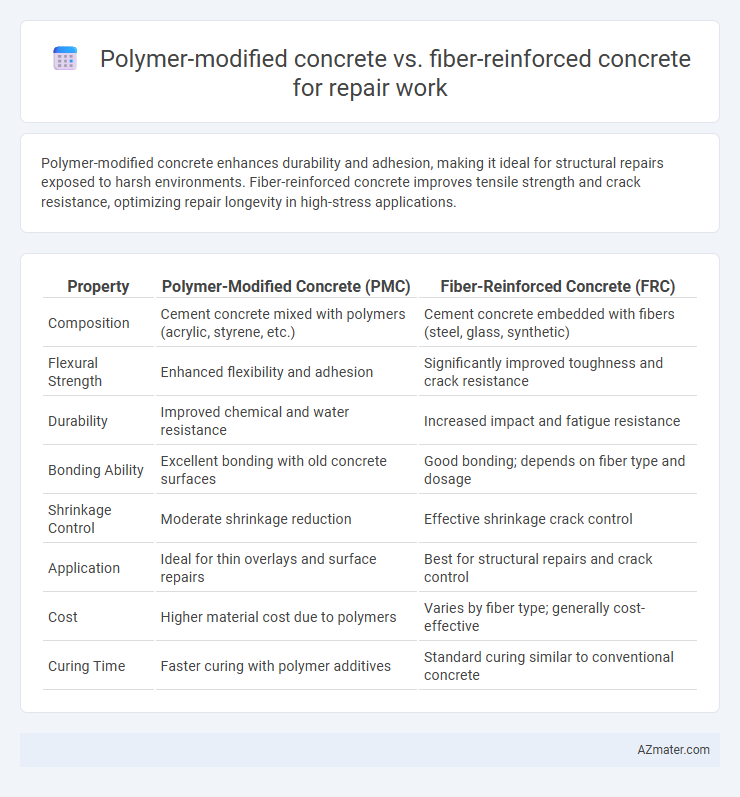Polymer-modified concrete enhances durability and adhesion, making it ideal for structural repairs exposed to harsh environments. Fiber-reinforced concrete improves tensile strength and crack resistance, optimizing repair longevity in high-stress applications.
Table of Comparison
| Property | Polymer-Modified Concrete (PMC) | Fiber-Reinforced Concrete (FRC) |
|---|---|---|
| Composition | Cement concrete mixed with polymers (acrylic, styrene, etc.) | Cement concrete embedded with fibers (steel, glass, synthetic) |
| Flexural Strength | Enhanced flexibility and adhesion | Significantly improved toughness and crack resistance |
| Durability | Improved chemical and water resistance | Increased impact and fatigue resistance |
| Bonding Ability | Excellent bonding with old concrete surfaces | Good bonding; depends on fiber type and dosage |
| Shrinkage Control | Moderate shrinkage reduction | Effective shrinkage crack control |
| Application | Ideal for thin overlays and surface repairs | Best for structural repairs and crack control |
| Cost | Higher material cost due to polymers | Varies by fiber type; generally cost-effective |
| Curing Time | Faster curing with polymer additives | Standard curing similar to conventional concrete |
Introduction to Concrete Repair Technologies
Polymer-modified concrete enhances adhesion, durability, and chemical resistance, making it ideal for repairing deteriorated structures exposed to harsh environments. Fiber-reinforced concrete incorporates synthetic or steel fibers to improve tensile strength, crack resistance, and impact durability, often used in structural repairs requiring enhanced load-carrying capacity. Both technologies address specific repair challenges by improving mechanical properties and longevity compared to traditional concrete mixes.
Overview of Polymer-Modified Concrete
Polymer-modified concrete (PMC) enhances traditional concrete by incorporating polymers such as styrene-butadiene rubber or acrylics, significantly improving adhesion, flexibility, and resistance to cracking. PMC exhibits superior bonding strength on old substrates and better durability under chemical exposure, making it highly suitable for structural repairs and patching deteriorated concrete surfaces. Its quick setting time and reduced permeability also contribute to longer service life and reduced maintenance costs in repair applications.
Overview of Fiber-Reinforced Concrete
Fiber-reinforced concrete (FRC) enhances repair work by incorporating various fibers such as steel, glass, or synthetic polymers, which improve tensile strength, crack resistance, and durability. Its ability to control shrinkage and reduce permeability makes FRC ideal for structural repairs subjected to dynamic loads and environmental stressors. By distributing stresses more evenly within the mix, fiber-reinforced concrete prolongs the lifespan of repair applications compared to traditional or polymer-modified concrete.
Key Material Properties Comparison
Polymer-modified concrete exhibits superior adhesion, flexibility, and chemical resistance, making it ideal for patching and sealing cracks in repair work. Fiber-reinforced concrete enhances tensile strength, impact resistance, and crack control due to the inclusion of synthetic or steel fibers within the matrix. Choosing between these depends on the specific repair requirements: polymer-modified concrete excels in bonding and durability, while fiber-reinforced concrete provides improved structural integrity and toughness.
Durability and Longevity Factors
Polymer-modified concrete enhances durability by improving bonding strength and resistance to chemical attacks, making it ideal for surface repairs subjected to harsh environments. Fiber-reinforced concrete increases longevity through improved tensile strength and crack control, effectively reducing shrinkage and fatigue damage in structural repairs. Selection between these materials depends on specific repair needs, balancing polymer benefits in adhesion and chemical resistance with fiber advantages in mechanical reinforcement.
Application Techniques and Workability
Polymer-modified concrete enhances adhesion and durability in repair work through easy application methods such as troweling and spraying, maintaining excellent workability even in thin overlays and intricate surfaces. Fiber-reinforced concrete improves tensile strength and crack resistance with techniques like pumping and casting, though fibers can reduce workability, requiring careful mix adjustments and specialized equipment for uniform distribution. Both materials demand precise handling to optimize their performance in structural repair and surface restoration contexts.
Crack Resistance and Flexural Strength
Polymer-modified concrete exhibits superior crack resistance due to its enhanced adhesion and flexibility, making it ideal for repair work where durability against cracking is critical. Fiber-reinforced concrete significantly improves flexural strength by distributing tensile stresses across fibers such as steel or polypropylene, preventing sudden failure under bending loads. Both materials offer distinct advantages: polymer modification provides excellent crack sealing properties, while fiber reinforcement enhances structural toughness and load-bearing capacity in repaired sections.
Cost Analysis and Economic Considerations
Polymer-modified concrete offers superior bond strength and durability at a moderate initial cost, making it suitable for critical structural repairs where longevity justifies expense. Fiber-reinforced concrete, with its enhanced crack resistance and reduced maintenance requirements, provides a cost-effective solution for large-scale or less structurally demanding repairs by minimizing long-term repair frequency. Economic considerations favor polymer-modified concrete for high-performance needs, while fiber-reinforced concrete optimizes overall project budgets through lower material and labor costs in extensive repair applications.
Ideal Use Cases for Repair Projects
Polymer-modified concrete excels in repair projects requiring enhanced adhesion, waterproofing, and chemical resistance, making it ideal for patching cracks, spalling, and deteriorated surfaces exposed to harsh environments. Fiber-reinforced concrete is best suited for structural repairs needing improved tensile strength, crack control, and impact resistance, such as bridge decks, slabs, and industrial floors subjected to heavy loads and dynamic stresses. Selecting between the two depends on specific repair demands, with polymer modification favored for durability and bonding, while fiber reinforcement targets reinforcement and crack mitigation.
Conclusion: Selecting the Best Concrete Solution
Polymer-modified concrete offers enhanced adhesion, chemical resistance, and durability, making it ideal for structural repairs requiring strong bonding and surface protection. Fiber-reinforced concrete improves tensile strength and crack resistance, suited for applications needing impact resistance and flexibility under stress. Choosing between the two depends on specific repair conditions, load requirements, and environmental factors to ensure long-term performance and cost-effectiveness.

Infographic: Polymer-modified concrete vs Fiber-reinforced concrete for Repair work
 azmater.com
azmater.com